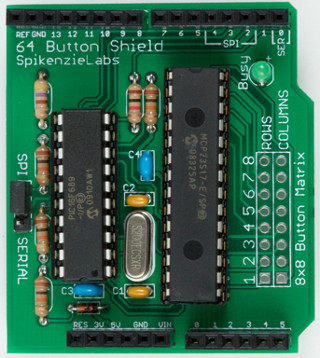SpikenzieLabs Button 64 Shield

Photo: SpikenzieLabs
Shield URL: Button 64 Shield
Tags:
Maker: SpikenzieLabs
The B64 is an Arduino Shield that allows you to connect up to 64 buttons to your Arduino. You can use the B64 to make custom musical instruments, attach a lot of inputs, cool computer interfaces, etc.
The B64 has two eight-pin connectors that make an eight row by eight column matrix for the total of 64 buttons. You do not have to format the button layout in a physical matrix nor do you have to use all of the 64 buttons. Unused buttons are simply ignored.
Open Source: Unknown
License: Unknown
Source: Unknown
|
|
Note:
There are two ways to interface the B64 with your Arduino Sketch. There is a shunt jumper on the shield that tells the B64 how it will communicate with the Arduino. The two modes are called SPI and Serial.
The serial mode uses the Arduino's built in Serial pin (RX, digital pin 0). The B64 communicates at a fixed baud rate of 57600bps 8N1. Note: The B64 has a special feature that allows the B64 to remain seated on the Arduino, even while you are uploading your sketches. So as not to cause sketch upload errors, the B64 automatically senses when the Arduino is receiving a new sketch and disconnects itself from the serial pin. (The serial pin is used by the Arduino while a sketch is being uploaded) It automatically reconnects to the serial pin (if in serial mode) after the sketch is finished uploading. During the Arduino sketch upload, the busy LED will be on.
In SPI mode the B64 uses digital pins 2,3 and 4 for a custom synchronous data transfer. Note: this is not a true SPI interface, it only uses three data lines; select, data in (out of shield, into Arduino) and clock. Also, this SPI will not work with the Arduino SPI library.
Once a mode is selected, the pins for the non-used mode are electronically disconnected from the B64 shield so your Arduino is free to use them.
|





































